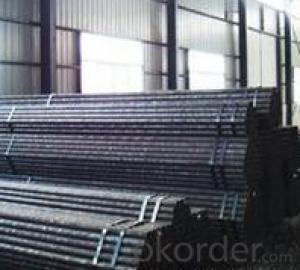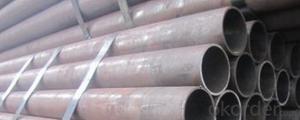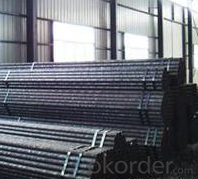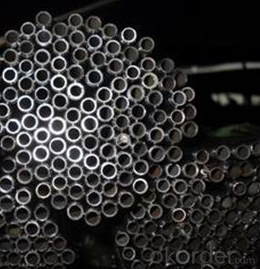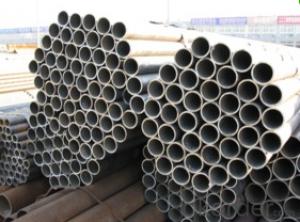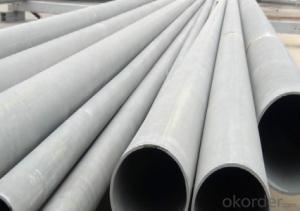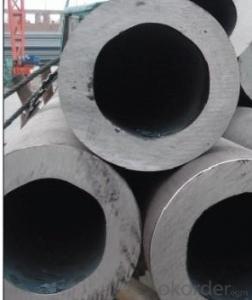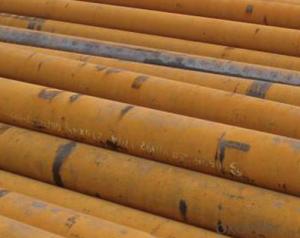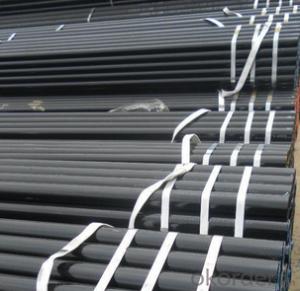Schedule 40 Seamless Carbon Steel Pipe 12Cr1MoV CNBM
- Loading Port:
- Qingdao
- Payment Terms:
- TT OR LC
- Min Order Qty:
- 10 pc
- Supply Capability:
- 30 pc/month
OKorder Service Pledge
OKorder Financial Service
You Might Also Like
Quick Details
| Thickness: | 1.73 - 59.54 mm | Section Shape: | Round | Outer Diameter: | 10.3 - 914.4 mm |
| Secondary Or Not: | Non-secondary | Application: | Fluid Pipe | ||
| Technique: | Hot Rolled | Certification: | API | Surface Treatment: | Galvanized,vanish covering, black painting, galvenized ect. |
| Special Pipe: | API Pipe | Alloy Or Not: | Non-alloy | Length: | 5-12m as per customer's requirements |
| SCH: | SCH10~160, STD, XS & XXS | Payment Terms: | L/C T/T | Supply Ability: | 5000 Ton/Tons per Week |
| Product: | pipe prices | Grade: | 10#,20#,45#,A106(B,C),A53(A,B),12Cr1MoV,12Cr1MoVG,12Cr2Mo,13CrMo44,13CrMo45,15CrMo,15CrMoG,St52,St52.4,10#-45#,A53-A369,Cr-Mo alloy,ST35-ST52 | Standard: | API 5CT,API 5L,ASTM A106-2006,ASTM A53-2007,DIN 17175,GB 3087-1999,GB 5130,GB 6479-2000,GB 9948-2006,GB/T 17396-1998,GB/T 5312-1999,GB/T 8162-1999,GB/T 8163-1999,API,ASTM,DIN,GB |
Packaging & Delivery
| Packaging Detail: | By bundles, seaworthy wooden cases, steel framed cases, and simple packaging or according to the demand of the customers. |
| Delivery Detail: | within 5-15 days |
Specifications
1.pipe prices
2.Supply Ability:5000 Tons per Week
3.Payment Terms:L/C T/T
High quality Carbon steel pipe, Best pipe prices
1) Application: Overheat pipe for low and mediumpressure boiler,boiling water pipe, locomotive smoke pipe(big and small),Carry gas ,water or oil in the industries of petroleum and natural gas etc
2) Materials: 10#, 20#, 45#, 15CrMo, 12Cr1MoV, 13CrMo44, 12Cr2Mo, 13CrMo45, 12Cr1MoVG, 15CrMoG, API J55, API K55, API N80, API L80, API P110
3)Pipe according to standard: GB 3087-1999, GB/T 8163-1999, GB/T 8162-1999, GB 9948-2006, GB/T 17396-1998, GB/T 5312-1999, GB 6479-2000, GB 5130, DIN 17175, API 5CT, API 5L .
4)Packing: By bundles, seaworthy wooden cases, steel framed cases, and simple packaging or according to the demand of the customers.
Technical Parameters of Seamless Steel Pipe
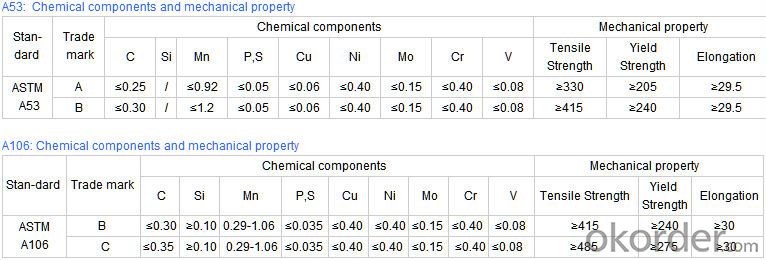
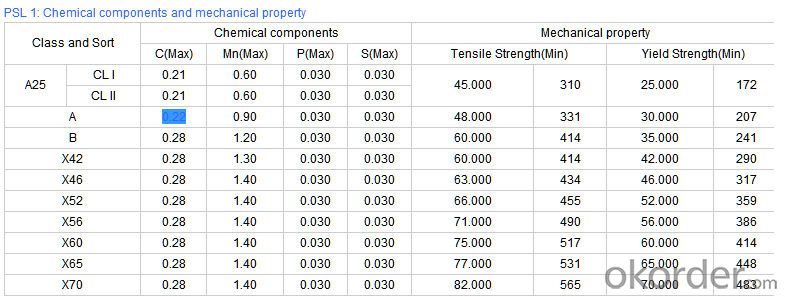
- Q: How do you inspect steel pipes for defects?
- There are several methods to inspect steel pipes for defects. One common approach is visual inspection, where trained professionals examine the surface of the pipes for visible defects such as cracks, corrosion, or deformities. Another method is ultrasonic testing, which involves using high-frequency sound waves to detect internal defects like wall thickness variations or cracks. Magnetic particle inspection is also commonly used, where the pipes are magnetized, and magnetic particles are applied to reveal surface defects. X-ray and radiographic inspections can be employed to detect internal defects as well. Ultimately, a combination of these methods is often utilized to ensure thorough inspection and identification of any defects in steel pipes.
- Q: What is the primary purpose of steel pipes?
- The primary purpose of steel pipes is to transport fluids and gases, such as water, oil, and natural gas, over long distances efficiently and safely. They are commonly used in various industries including construction, oil and gas, and infrastructure development.
- Q: How do steel pipes perform in extreme temperature variations?
- Steel pipes perform well in extreme temperature variations due to their high thermal conductivity and resistance to expansion and contraction. They are able to withstand both high and low temperatures without losing their structural integrity or experiencing significant changes in dimensions. This makes steel pipes suitable for a wide range of applications, including those in industries with extreme temperature conditions, such as oil and gas, chemical processing, and power generation.
- Q: What are the different sizes of steel pipes available?
- Steel pipes are available in a wide range of sizes, varying from small diameter pipes used for plumbing applications to large diameter pipes used for industrial purposes. The sizes typically range from 1/8 inch to 72 inches in diameter, with various wall thickness options.
- Q: How do you clean steel pipes?
- To clean steel pipes, you can follow a few steps: 1. Gather the necessary materials: You will need a pipe cleaning solution, a scrub brush or wire brush, and safety equipment such as gloves and goggles. 2. Prepare the cleaning solution: Dilute the pipe cleaning solution according to the instructions provided on the packaging. Make sure to choose a solution that is suitable for steel pipes. 3. Safety first: Put on your safety equipment to protect yourself from any potential hazards. 4. Remove any debris: Before applying the cleaning solution, remove any loose debris or dirt from the surface of the steel pipes. You can use a brush or a cloth to wipe away any visible particles. 5. Apply the cleaning solution: Dip the brush into the prepared cleaning solution and apply it to the steel pipes. Make sure to cover the entire surface, focusing on any areas with stubborn dirt or grime. 6. Scrub the pipes: Use the brush to scrub the steel pipes thoroughly, applying pressure as needed to remove any buildup or stains. Pay extra attention to joints or areas that are difficult to reach. 7. Rinse with water: Once you have finished scrubbing, rinse the pipes with clean water to remove the cleaning solution and any remaining dirt. You can pour water over the pipes or use a hose if available. 8. Dry the pipes: After rinsing, use a cloth or towel to dry the steel pipes completely. This will help prevent any water stains or corrosion. 9. Inspect for cleanliness: Take a moment to inspect the pipes and ensure they are clean. If there are still areas with stubborn dirt or stains, you may need to repeat the cleaning process or consider using a different cleaning solution. Remember to always follow the manufacturer's instructions when using cleaning solutions and to take proper safety precautions.
- Q: Can steel pipes be used for desalination plants?
- Yes, steel pipes can be used for desalination plants. Steel pipes are commonly used in desalination plants to transport and distribute water, as they are durable, resistant to corrosion, and can handle high-pressure systems.
- Q: Can steel pipes be used for underground chemical pipelines?
- Yes, steel pipes can be used for underground chemical pipelines. Steel pipes are widely used in various industries, including the chemical industry, due to their durability, strength, and resistance to corrosion. When selecting steel pipes for underground chemical pipelines, it is important to choose the appropriate grade of steel that is resistant to corrosion from the specific chemicals being transported. Additionally, proper coating and lining techniques can further enhance the resistance of steel pipes to chemical corrosion. Regular inspection and maintenance are also necessary to ensure the integrity and safety of the underground chemical pipeline system.
- Q: What are the common sizes of steel pipe fittings?
- The common sizes of steel pipe fittings range from 1/8 inch to 24 inches in diameter.
- Q: What are the safety precautions to follow when working with steel pipes?
- When working with steel pipes, it is important to follow several safety precautions to ensure the well-being of yourself and those around you. These precautions include: 1. Personal Protective Equipment (PPE): Always wear the appropriate PPE when working with steel pipes. This includes safety glasses, gloves, steel-toed boots, and a hard hat. PPE helps protect you from potential hazards such as flying debris, falling objects, and sharp edges. 2. Proper Lifting Techniques: Steel pipes can be heavy and awkward to handle. Always use proper lifting techniques to avoid strain or injury. Bend your knees, keep your back straight, and use your legs to lift the pipes. If a pipe is too heavy to lift on your own, ask for assistance or use mechanical lifting equipment. 3. Secure Working Area: Ensure that the work area is clean, organized, and free from tripping hazards. Keep the floor clear of tools, debris, and other obstructions that may cause accidents. Additionally, barricade or cordon off the work area to prevent unauthorized access and ensure the safety of others. 4. Use Proper Tools and Equipment: Use the right tools and equipment for the job. This includes using wrenches, pipe cutters, and clamps designed specifically for steel pipes. Using improper tools can lead to accidents, damage to the pipes, or faulty connections. 5. Proper Storage: Store steel pipes in a secure and organized manner to prevent them from falling or rolling onto someone. Stack the pipes in a stable position, and use racks or supports to ensure they are not at risk of toppling over. 6. Secure Connections: When joining steel pipes, ensure that the connections are properly secured. This includes using appropriate fittings, tight fasteners, and following the recommended torque specifications. Loose or improperly secured connections can result in leaks, bursts, or other failures. 7. Proper Ventilation: If working in an enclosed space, ensure adequate ventilation to prevent the buildup of harmful gases or fumes. Welding or cutting steel pipes can release hazardous gases, so make sure the area is properly ventilated or use respiratory protection if necessary. 8. Fire Safety: Steel pipes can become extremely hot during welding or cutting processes. Have fire extinguishers readily available and know how to use them. Clear any flammable materials from the work area and be cautious of sparks or open flames. 9. Regular Inspections: Regularly inspect steel pipes for signs of damage, such as cracks, rust, or degradation. Replace any damaged or compromised pipes to avoid potential failures or accidents. By following these safety precautions, you can minimize the risks associated with working with steel pipes and ensure a safe working environment. Remember, safety should always be the top priority.
- Q: What are the different types of steel pipes?
- There are several different types of steel pipes, including seamless pipes, welded pipes, galvanized pipes, and stainless steel pipes.
Send your message to us
Schedule 40 Seamless Carbon Steel Pipe 12Cr1MoV CNBM
- Loading Port:
- Qingdao
- Payment Terms:
- TT OR LC
- Min Order Qty:
- 10 pc
- Supply Capability:
- 30 pc/month
OKorder Service Pledge
OKorder Financial Service
Similar products
Hot products
Hot Searches
Related keywords
